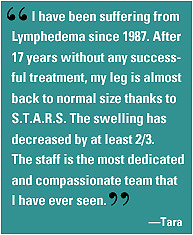 Benefits
of Manual Lymph Drainage (MLD)
According to the National Lymphedema Network,
30-40% of Breast Cancer survivors will develop lymphedema in their lifetime.
Become knowledgeable, and reduce the odds. Benefits
of Manual Lymph Drainage (MLD)
According to the National Lymphedema Network,
30-40% of Breast Cancer survivors will develop lymphedema in their lifetime.
Become knowledgeable, and reduce the odds.
Lymphedema has not been widely understood, and many have lived for years, with
the untreated symptoms of deformed, enlarged, heavy limbs, skin problems and
infections. Life for a person at risk or living with lymphedema need not be much
different than for the individual whose lymphatic system is functioning normally.
Healthy living with lymphedema does require being informed, making adjustments,
and committing to precautions. It is in the spirit of support and empowerment,
that I offer this information.
Lymphedema manifests as swelling — principally in the subcutaneous fat layer
under the skin. Injury, surgery, radiation, and congenital defect are causes,
but regardless of the cause, the result is that the lymphatic system is limited
or unable to perform its normal functions.
Primary Lymphedema is a congenital condition in which there are insufficient
lymphatic structures. The symptoms of edema may be manifest at birth, or may
be delayed until adolescent years, or even into the mid-thirties. The majority
of individuals suffering from primary lymphedema are women, and the edema most
often occurs in the lower extremities.
|